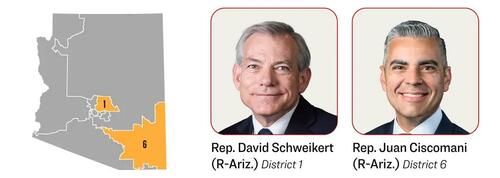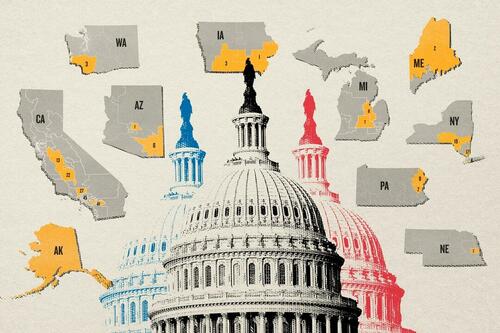Preparing For The Steal
Preparing For The Steal
Authored by Jeff Carlson & Hans Mahncke via Truth Over News,
Georgia, the site of massive election misinformation, questionable results, incomplete audits and a mysterious come-from-behind razor-thin win by Joe Biden in 2020, appears to be at it again. Or perhaps we should say Georgia Secretary of State Brad Raffensperger is at it again.
Kylie Jane Kremer brought the matter to our attention through a series of posts on X. As Kremer notes, “Raffensperger sent an email, in a private capacity, that went to a list of trial lawyers across Georgia soliciting $5 million by November 1st to help in his effort for a 501(c)4 called “Election Defense Fund”, asking lawyers to donate or contact him via his private gmail account & personal cell phone number.”
In the email, Raffensperger claimed that “Election deniers and conspiracy theorists have taken their anger to new levels, employing a variety of tactics including intimidation, legal challenges, and rule changes. In Georgia they have threatened, harassed, and sued election officials. And as you know, most recently the Georgia State Election Board was taken over by three individuals who have pledged to put partisanship over sworn duty.”
Raffensperger appears to be referring to (and trying to intimidate) the three Republican members of Georgia’s five -person State Election Board, Dr. Janice Johnston, Rick Jeffares and Janelle King.
Raffensperger also appears to be attempting to intimidate and silence anyone who might challenge the outcome of Georgia’s 2024 presidential election.
On September 20th, Johnston, Jeffares and King voted in favor of requiring a hand count of all ballots to ensure that the number of physical ballots equaled the machine count total at the precinct level. This new rule was opposed by Georgia state elections officials, including Raffensperger, who said it could create chaos and confusion on Election Day.
In advance of the vote by the State Election Board, Raffensperger issued a formal statement, claiming that “Activists seeking to impose last-minute changes in election procedures outside of the legislative process undermine voter confidence and burden election workers… misguided attempts by the State Election Board will delay election results and undermine chain of custody safeguards. Georgia voters reject this 11th hour chaos, and so should the unelected members of the State Election Board.”
If you find it odd that Raffensperger would refer to his three fellow Republicans as “activists” while he worked to thwart common-sense changes that would dramatically increase the security of Georgia’s 2024 election, you’re not alone.
Raffensperger was apparently so concerned that he rushed to CNN-affiliate WSB, breathlessly claiming that “the State Election Board wants to take us back in time. I guess what they want is to see elections take until 3 a.m. like in Detroit, Michigan. We don’t want to do that in Georgia. Not on my watch.”
Although the move by the three Georgia Republicans had the support of President Trump, lawsuits were immediately filed – and on October 16th a Georgia court blocked the rule changes, inexplicably declaring that they were “illegal, unconstitutional and void.”
We don’t have a copy of the email (Kremer doesn’t have the full email either) but Georgia’s GOP Chairman Josh McKoon appeared to confirm the email was real in a post on X.
McKoon stated that “This email communication by Mr. Raffensperger is a dangerous and unwarranted attack on sworn elections officials doing their duty which threatens to interfere in the conduct of the election and undermine confidence in the outcome.”
McKoon went on to write that Raffensperger “spitefully harasses and undermines the public servants who have stepped up to do the job that he so spectacularly failed to do in 2020 and solicits $5 million for a secret, dark money fund “not subject to public disclosure” to dox and threaten election officials.”
As we mentioned earlier, Kremer included screenshots of the email in her post. In those screenshots was a snapshot of the address of the website, Elections Defense Fund, that Raffensperger purportedly established for the purposes of raising donations.
We looked the Elections Defense Fund up and found the site to be sparse but the language matches what is said in the email:
“Election Defense Fund, Inc. is a 501(c) (4) dedicated to protecting this year’s election results, and standing up against those who attempt to delay certification.”
“Election Defense Fund, Inc will identify local election officials who are most likely to not certify or otherwise attempt to interfere with results; educate the public to remind election officials of their duty to follow the law and the potential consequences of not doing so; support lawsuits that seek to force election officials to uphold their legal duties, and defend election officials who are harassed, targeted, or sued for doing their lawful duties.”
The site notes that “Contributions to Election Defense Fund, Inc. are confidential and not disclosed to the public and are not deductible as charitable contributions for federal income tax purposes.” The site, which claims to be a “a non-profit 501 c(4) organization” also states that it’s “Not endorsed by any candidate or candidate committee.”
Kremer also obtained what appears to be official registration paperwork from Raffensperger’s Secretary of State office for the 501(c)4 Election Defense Fund. Included in the paperwork is a reference to Ryan Germany, general counsel for Georgia’s secretary of state’s office. Germany, who was an integral part of the Georgia election fiasco, appears to be listed as both the secretary (p.1) and the incorporator (p.3) of the Election Defense Fund.
If, as it appears to us, Raffensperger is involved in his official capacity as Secretary of State, it seems likely to us that everything surrounding the Election Defense Fund should be a matter of public record – or at least subject to FOIA requests. How Georgia’s Secretary of State could be directing a private effort to raise funds to silence other public election officials is beyond our comprehension.
This preemptive attempt to silence anyone questioning Georgia’s election results seems particularly relevant after Raffensperger recently appeared on Face the Nation and stated that voting results could be delayed for three additional days after the November 5th election.
Raffensperger said that Georgia “would be waiting for the overseas ballots that come in no later than Friday, and so those will then be the final numbers.” Raffensperger may have also unintentionally foreshadowed events when he added “And we’ll just see if that makes the difference in the total vote totals.”
Given the extraordinarily slim margin in Georgia’s 2020 presidential election, these overseas votes could prove critical. According to Raffensperger, 21,075 military and overseas Georgia ballots had been requested as of October 21st. By way of comparison, Biden’s margin of “victory” in Georgia was less than 12,000 votes.
As you may recall, Raffensperger featured prominently in the chaos and controversy surrounding the results of the 2020 election in Georgia. An election that was ultimately decided in favor of Biden – who “won” by a razor-thin margin after an unexplained delay in vote counting in the middle of the night.
And, of course, Biden’s narrow margin of victory was dwarfed by more than 350,000 ballots in Georgia that lacked any chain of custody documentation – along with another nearly 107,000 ballots that had improper chain-of-custody documentation.
But there’s also something larger at play as well. It seems that the coordination extends beyond Raffensperger and Georgia to include other Secretaries of State in crucial battleground states. Michigan’s SoS Jocelyn Benson gave up this information during an appearance on the MeidasTouch podcast that was uncovered by Kylie Kremer.
Benson was asked about her work as a “part of a group of Secretaries of State” that are coordinating across state lines. Benson’s response was eye-opening:
One of the things we saw in 2020 was that particularly in battleground states, we are all battling a common adversary, a really nationally coordinated effort to undermine the will of the people, both before, during and after election day.
We learned to semi-coordinate with each other in 2020… We would talk regularly, but there was really no way for us – the six of us in those six battleground states, Wisconsin, Pennsylvania, Michigan, Arizona, Nevada and Georgia – to constantly both compare notes and also say, OK, how are we going to respond to this nationally coordinated effort with a coordinated response?
Now we have that. We actually spent 2022 working to build that team in these six states. You’ve got strong voices now in Arizona and Nevada and Georgia, Wisconsin and Pennsylvania and in Michigan. And we’re all talking. We’re all working together. We’re all very clear-eyed about what we’re up against.
Because the battle over the future of our democracy isn’t going to be in the post-election process only. It starts now and it starts with how various court battles are playing out and we’ll see all of us getting hit with the same types of sham lawsuits that are PR campaigns masquerading as lawsuits.
So as we work together, as we talk to each other, we can develop common strategies and be much more powerful and united as a team – even across party lines – then we would be if we were just fighting these battles in our respective states by ourselves.
There we have it. A group of powerful Secretaries of State are coordinating (across state lines) in battleground states to work together in coordinated fashion. Working to push back on challenges to election certification.
Making matters worse, Benson is the same SoS who famously proclaimed “if someone were to violate the law and not certify the election at the local level, we will come for you! So any local certifier who’s thinking of skirting the law and not certifying the vote, don’t even think about it, because we’ll get you.”
Benson’s declaration is actually extraordinarily similar to the language in Raffensperger’s email and the description listed on Raffensperger’s donation website:
“Election Defense Fund, Inc will identify local election officials who are most likely to not certify or otherwise attempt to interfere with results; educate the public to remind election officials of their duty to follow the law and the potential consequences of not doing so; support lawsuits that seek to force election officials to uphold their legal duties, and defend election officials who are harassed, targeted, or sued for doing their lawful duties.”
We were fairly involved in reporting during the aftermath of Georgia’s 2020 election (articles here, here, here, here & here) and can state decisively that we don’t trust Raffensperger for a single second. As we’ve said many times, we’ve long believed that something is rotten in Georgia.
But we didn’t realize the rot was being coordinated across state lines.
Subscribe to Truth Over News here…
Tyler Durden
Fri, 10/25/2024 – 07:20
Can BRICS Deliver On Its Promises?
Can BRICS Deliver On Its Promises?
Authored by RFE/RL Staff via OilPrice.com,
-
Putin is using the BRICS summit to project strength and counter Western isolation, while also pushing for initiatives like an alternative payment system and grain exchange.
-
BRICS members are divided on their approach to the West, with some seeking to reform the current international order and others aiming to dismantle it.
-
Despite its growing economic influence, BRICS faces internal challenges and a mixed track record in achieving its goals.
As Russian President Vladimir Putin hosts leaders for the 16th annual BRICS summit, he’s determined to show the West that he still has important allies by his side after nearly three years of attempts to isolate Russia for its full-scale invasion of Ukraine.
But while Putin is getting the optics he wants, what kind of an organization is BRICS actually growing into?
Finding Perspective:
The summit in Kazan, which began on October 22 and will run until October 24, is the first meeting for the group since Egypt, Ethiopia, Iran, and the United Arab Emirates joined past members Brazil, Russia, India, China, and South Africa.
Putin is looking to use BRICS, or BRICS+ as the expanded format is sometimes termed, to signal that Russia has plenty of influential friends, despite its pariah status in the West.
The summit is intended to showcase the group’s collective economic might and also entice new countries into a coalition that Moscow and Beijing hope will help form a new world order not dominated by the West.
In Kazan, Putin is expected to push negotiations to build an alternative platform for international payments that would be immune to Western sanctions.
Russia, the world’s top wheat exporter, will also propose the creation of a BRICS grain-trading exchange as an alternative to Western markets where international prices for agricultural commodities are set.
But not all BRICS members completely align with the anti-Western stance coming from Beijing and Moscow and this divide could come out in Kazan.
The Balancing Act:
While all BRICS members may be united in the “belief that the current structures that govern the international order and the global economy are unfairly weighted toward the Western world,” Stewart Patrick, a senior fellow at the Carnegie Endowment for International Peace, told me, there is a division between China, Iran, and Russia, which want to unseat the current order, and others who want to reform it.
Many BRICS members, like Brazil and India, still work closely with the United States and other countries in the West, even as they seek to gain more global leverage.
For many of the new members, with the exception of Iran — and also for many that have applied to join recently — BRICS holds mostly economic appeal.
Members and would-be members alike are also looking for alternative sources of financing than available from the World Bank and International Monetary Fund (IMF), and are looking to gain better access to burgeoning markets that could better define the global economy in the coming decades.
Why It Matters:
Beyond the financial appeal of the bloc, many countries also view BRICS as a form of geopolitical insurance.
And that hedge is even more relevant given added unpredictability brought to the United States in recent years.
Still, the divisions within BRICS — and the bloc’s so far thin track record in delivering on its initiatives — could continue to hold it back.
China, Iran, and Russia represent a group within BRICS that are grappling to varying degrees with U.S. sanctions and fighting different types of proxy battles with the United States around the world.
Others, like Egypt, are leading recipients of U.S. military aid or like the United Arab Emirates, host U.S. military bases.
Adding to those difficulties in articulating what a shared vision for the BRICS would look like, China and India have difficult relations, while there is little warmth to be found between Arab states and Iran.
Tyler Durden
Thu, 10/24/2024 – 23:25
People Are Back And “Demanding Beach Front Houses” Days After Florida Ravaged By Hurricanes
People Are Back And “Demanding Beach Front Houses” Days After Florida Ravaged By Hurricanes
Everybody said no one would want to wind up back in Florida after it was ravaged by two hurricanes this month…and once again, it looks like “everyone” is wrong.
Such was the conclusion of a recent Bloomberg article which detailed “one of the largest real estate brokerages in Boca Grande, a village on Florida’s Gasparilla Island” which has seen immediate demand following the storms.
“We’re already having people calling, investors, some bottom fishers, saying, ‘I will buy anything in cash and close in two weeks,’” brokerage founder Michael Saunders told Bloomberg.
He added: “People’s memories are short when it comes to the disastrous things that come with a storm. They forget and are right back demanding beach front houses.”
Milton was the third hurricane to hit the island in two years, the report notes. In 2022, Ian flooded streets and damaged roofs. Helene followed this September, surging through dunes and mangroves, leaving two feet of water in Boca Grande’s shops.
Just ten days later, Milton struck again, flooding luxury homes, condos, and downtown businesses still recovering from Helene. It knocked out power and water, tore up banyan-lined roads, and left sand drifts around the Gasparilla Inn, a favorite of the Bush presidential family.
The Bloomberg article says that Boca Grande, long associated with old money, saw property values soar during the pandemic, with median home prices more than doubling to $4 million since 2019, per Redfin. However, home sales have recently dropped to a quarter of their 2021 peak, mirroring a 30% decline statewide.
After Hurricane Milton, Lee County Sheriff Carmine Marceno flew in by helicopter, offering what he called a “concierge-level” response. Crews quickly cleared five-foot sand drifts, allowing workers to restore power, repair roads, and dig out luxury homes.
Marceno said: “People needed to know we are here. Our mission was to get this place open, so people could come back to check their property.”
Glenn Scarpa, owner of restaurant Scarpa’s Coastal, said he’s tired of rebuilding. Milton flooded his restaurant with over three feet of water, hitting before it even dried out from Helene.
He said: “The boo-hoo period is over, and now I just have to focus on rebuilding my life — again. What more can I do?”
Down the beach, Milton ended the short-lived revival of South Beach Bar & Grille, which had reopened only weeks after being destroyed by Hurricane Ian. The storm shattered windows, eroded sand, and cracked the foundation. Co-owner Marco Meola fought back tears as he surveyed the damage.
Meola said: “Hurricane Ian was really devastating, an emotional roller coaster that took a lot of toll on us, and now this. We feel like if we can survive that, we can come back from this.”
Tyler Durden
Thu, 10/24/2024 – 18:00
20 Races That Could Determine Control Of The House
20 Races That Could Determine Control Of The House
Authored by Joseph Lord, Stacy Robinson via The Epoch Times (emphasis ours),
While most national attention is on the top-of-the-ticket race between former President Donald Trump and Vice President Kamala Harris, control of Congress will be equally consequential.
Republicans currently hold a narrow majority of eight seats in the House, meaning they can only spare three defections on big votes. Democrats, with four independents, hold a one-seat majority in the Senate and the tie-breaking vote.
While Republicans are favored to reclaim the Senate, the fate of the House remains more uncertain.
Whoever is president will need full control of Congress to get much done during their term.
House Republicans seek to grow their thin, ideologically divided majority and Speaker Mike Johnson (R-La.) has indicated his intention to seek reelection as speaker.
Democrats are seeking to reclaim the majority, which they controlled from 2019 to 2023, and to place House Minority Leader Hakeem Jeffries (D-N.Y.) in the speaker’s chair.
Of the 435 House races, there are around two dozen that are expected to ultimately determine control of the House of Representatives in the 119th Congress.
Each race listed here is rated by the Cook Political Report as a “toss-up,” making these races among the hardest to predict.
New York
Republican control of the House is largely due to the party’s victories in New York in 2022, when several Republicans won districts that had voted for candidate Joe Biden just two years prior.
While the expected red wave didn’t fully materialize nationwide, there was a notable Republican surge in New York.

The most surprising win was Rep. Mike Lawler’s (R-N.Y.) defeat of incumbent Rep. Patrick Maloney (D-N.Y.), the then-chair of the Democrats’ House campaign arm.
Lawler, whose district lies just north of New York City, won by a 0.6 percent margin in an upset that shocked even bullish Republicans.
This year, Lawler is leading his Democratic opponent, Mondaire Jones, by just one point, an Oct. 3 Emerson College poll shows.
Meanwhile, Reps. Marc Molinaro (R-N.Y.) and Anthony D’Esposito (R-N.Y.)—both of whom represent Biden-voting districts—are also seeking to hold onto their closely contested seats.
Molinaro won by just around a 1.6 percent margin, while D’Esposito enjoyed a more comfortable 3.6 percent.
Current polling results for both candidates lie in the margin of error: the most recent polling of each race has each trailing the Democrat candidate by three points.
However, other polling showed D’Esposito in a stronger position, leading earlier polling by six points.
Although the results in 2022 suggested New York could be trending Republican, it remains to be seen if the party can maintain that momentum in 2024.

California
Equally important to Republicans’ narrow reclamation of the House in 2022 was California, where Republicans also made gains in districts outside of the blue strongholds that dot the state’s coast.
Now, several GOP incumbents face tight reelection battles to hold on to those districts.
Five California Republicans—Reps. John Duarte, David Valadao, Mike Garcia, Ken Calvert, and Michelle Steel—are in extremely close races. All but one of these districts voted for Biden in 2020, highlighting their competitive nature.
Duarte narrowly won his central California seat in 2022 with 50.2 percent to his Democratic opponent’s 49.8 percent, a difference of just 0.4 percent. Polling this cycle shows them neck and neck, with the latest poll giving the Democrat a 1-point edge.
Valadao, who won by a 3-point margin in 2022, faces a much closer race this time, with recent polling showing the race tied.
Garcia won by 6.4 points last cycle, but polling shows him trailing by two points in his northern Los Angeles district.
Calvert and Steel both won by more than four points in 2022. This time around, Steel is again ahead by four points, while Calvert is tied with his Democratic opponent.
Holding these seats is vital for the Republicans to maintain or grow their House majority in 2024.

Rust Belt
While Republicans may be on the defensive in blue strongholds like New York and California, Democrats are similarly on the defensive in two of this election’s most crucial states: Michigan and Pennsylvania.
At the presidential level, these two states are expected to play a huge role in determining the ultimate victor in the election.
These states, along with Wisconsin, were once known as the “Blue Wall” for their long streak of backing Democrats and formed the backbone of their electoral strategy.
Since Trump, however, Republicans have seen a resurgence in the region as its many white working-class voters move over to the GOP camp.
In both 2016 and 2020, these three states, particularly Wisconsin and Pennsylvania, were decided by razor-thin margins.
In Michigan—generally considered the most liberal of the three—Republicans are vying to flip control of two open seats abandoned by Reps. Elissa Slotkin (D-Mich.) and Dan Kildee (D-Mich.).
While Slotkin won by 5 percent in 2022 and Kildee won by 10 percent, polling shows that the two races are on track to be far more competitive this time.
Republicans lead by four points in Slotkin’s 7th Congressional District, according to polling from early October, and by a single point margin in Kildee’s 8th Congressional District, according to polling from the beginning of August.

Picking up one or both of these seats would represent a major gain for Republicans, who stand to benefit from the loss of the two Democratic incumbents.
Over in Pennsylvania, considered the most consequential swing state this cycle, Reps. Susan Wild (D-Pa.) and Matt Cartwright (D-Pa.) are seeking to hold their seats.

Wild, representing Allentown and its environs, won by a narrow two-point margin in 2022.
Recent polling suggests she’s on track to hold the seat, with the most recent poll ending Oct. 3 finding a six-point lead for Wild.
Cartwright, meanwhile, won with 51 percent to Republicans’ 48 percent in 2022. Polling this cycle shows a 3.1 percent lead for Cartwright, though low sample sizes in these polls mean the race is still within the margin of error.
Arizona
Arizona, another battleground state, is home to some of the most contested races in the 2024 cycle.
Two Republican incumbents, Reps. David Schweikert (R-Ariz.) and Juan Ciscomani (R-Ariz.), face tough reelections in districts that narrowly voted for Biden in 2020.

Schweikert won his 1st Congressional District seat in 2022 by less than 1 percent of the vote after the district backed Biden by 1.5 percent in 2020.
Polling shows a slight edge for Democrats, who led by 1 percent in a poll that concluded on Aug. 13, though two earlier polls showed a tie. More recent polling isn’t available.
Ciscomani won his 6th district seat by similarly thin margins in 2022, securing 50 percent to Democrats’ 49 percent. Like Schweikert, his district backed Biden in 2020 by around 1.1 percent.
There’s no recent polling available for Ciscomani’s race.
Retaining the districts is crucial for Republicans to grow their House majority, with both expected to be decided by razor-thin margins in 2024.
Read the rest here…
Tyler Durden
Thu, 10/24/2024 – 06:30
FEMA’s Real Purpose: Suppressing Americans And Preventing Civilian Organization
FEMA’s Real Purpose: Suppressing Americans And Preventing Civilian Organization
Authored by Brandon Smith via Alt-Market.us,
The Federal Emergency Management Agency (FEMA) was founded on April 1st, 1979 under the Jimmy Carter Administration during the height of a nearly decade long stagflationary crisis and the Iranian oil crisis. Under Executive Order 12127, its stated goal was to centralize all disaster related efforts under a single top-down entity. Specifically, FEMA ended the more localized Civil Defense Agency, which was focused on community based emergency response, and it federalized all disaster coordination under a single top-down system controlled by the Oval Office.
FEMA was eventually placed under the purview of the Department of Homeland Security, creating even more centralization. The reason for FEMA according to the government is to aid Americans during and after a national level disaster event; anything from earthquakes to hurricanes to terrorist attacks.
That said, it should also be noted that FEMA was officially created on April Fool’s Day.
The true purpose of FEMA has long been obscured but some disturbing truths have been exposed in the past. The declassification of a program called Rex 84 (tied to Operation Garden Plot) revealed that FEMA was working directly with the Department of Defense on a hypothetical strategy to round up and detain large numbers of civilians considered a “threat to national security.” In other words, FEMA was to act as a tool for helping suppress civil disturbances, it was not necessarily designed to help Americans in times of need.
This was likely always the intent behind the founding of FEMA, but George H.W. Bush and Oliver North are cited as the men that truly militarized FEMA in the early 1980s. The goal to establish a mechanism for controlling domestic political dissent and suspending constitutional freedoms was exposed not long after FEMA’s founding. Oliver North was visibly enraged when the subject was broached in a congressional hearing during the Iran/Contra scandal.
It should be mentioned that the REX 84 documents do not list FEMA as a primary agency in control of civil disturbance response. This is where the accusations of “conspiracy theory” usually come from – FEMA is not the end-all-be-all agency in charge of locking down American rebellion. In fact, FEMA’s role is strangely ambiguous and is not clearly defined. All that is known is that they are indeed an element of Operation Garden Plot and have participated in REX exercises.
There’s no denying that the secrecy around civil disturbance programs is pernicious and suggests that there is far more going on than our own government cares to admit. To uncover FEMA’s real intent all we have to do is examine how they behave.
The recent Hurricane Helene disaster and FEMA’s handling of the response across the East Coast echos the agency’s crimes after Hurricane Katrina in New Orleans in 2005. Their emergency “aid” is used as a cloak to hide efforts to actually STOP communities from helping each other and preventing outside civilian funded supplies from reaching affected residents in need.
Desperate residents during Katrina were treated like prisoners rather than citizens, gun confiscation took place in many areas and some people were shot for trying to leave locked down neighborhoods. (As a side note – this is why you should NEVER let anyone confiscate your firearms, especially if those people are sent by the government)
CNN reported in 2008 that FEMA confiscated at least $85 million in donated goods and prevented them from reaching Katrina disaster victims. This included clothing, bedding, food and medical supplies. They stored these materials for years and then GAVE AWAY the supplies long after Katrina was over. FEMA claimed the supplies were “in excess to their needs.” This report and all related articles now seem to be missing from CNN’s archives.
We just witnessed a repeat of this behavior from FEMA and the affiliated agencies within their oversight. We saw local EMS being advised to prevent civilians from helping their communities. Supplies were once agaun being blocked, people with drones were being told not to help find survivors, people with helicopters are were threatened for helping save survivors and little aid reached Helene victims for weeks. Elon Musk’s Starlink was even been prevented from providing satellite internet services to affected regions until the story went national and the Department of Transportation was forced to address the problem.
It’s Katrina all over again, and FEMA always seems to have excuses.
But why? You would think that with an election only weeks away Biden and Harris would be jumping at the chance to look competent and useful. Instead, they did nothing other that offer a $750 relief check to survivors (which might help people survive for a week) and then referred people to federal programs which take many months to benefit from.
I argue that this is all deliberate. FEMA and the federal government at large are still using Operation Garden Plot-like protocols with two goals in mind…
First, they are trying to acclimate the populace to the idea that civilians can’t help themselves and that they should do nothing. They do this by constantly interfering with civilian efforts and disrupting donations. If civilians are working on their own to save US communities from calamity then they might one day realize they don’t need the Federal Government for anything. The establishment NEEDS people to believe that they can’t survive without government aid and protection. Luckily, at least in the aftermath of Helene, it seems that many communities are working on their own to fix the situation.
If civilians start doing things for themselves, the establishment machine becomes obsolete.
Second, I suspect FEMA is testing the waters to see how much they can get away with. Katrina was a clear beta-test for martial law disguised as an emergency response. Katrina was Garden Plot and Rex-84 realized. They want to see what Americans will put up with. Helene is yet another opportunity for these agencies to apply overt control and see if Americans will conform or rebel.
If FEMA is truly sincere in their efforts to help Americans they certainly don’t act like it. The criticism surrounding Helene is ramping up and FEMA’s indignant attitude towards their own failures in unacceptable. They should be punished for failing in their duties. That is assuming they are actually failing.
Maybe they consider the tragedy of government inaction surrounding Helene a success? The underlying point is, when disaster comes your way, it’s not enough to merely count FEMA out as a source of aid. That’s obvious. But you will also have to consider the possibility that the agency will work directly against you and your neighbors should you try to help yourselves.
* * *
If you would like to support the work that Alt-Market does while also receiving content on advanced tactics for defeating the globalist agenda, subscribe to our exclusive newsletter The Wild Bunch Dispatch. Learn more about it HERE.
Views expressed in this article are opinions of the author and do not necessarily reflect the views of ZeroHedge.
Tyler Durden
Wed, 10/23/2024 – 23:25
Apple “Might Wind Down” Vision Pro Production Next Month Due To “Weak Demand”
Apple “Might Wind Down” Vision Pro Production Next Month Due To “Weak Demand”
A new report from The Information suggests Apple might suspend production of its Vision Pro mixed-reality headset as early as next month due to very weak demand. Some Asian suppliers have already reduced or stopped producing headset components since the summer. Additionally, the development of the next Vision Pro model has been delayed, while a more affordable headset is slated for the retail market by the end of 2025.
The first version has met weak demand, a result of its high price and the lack of apps available on it. Employees at three Vision Pro suppliers that supply a range of electrical and mechanical components told The Information they have so far built enough components for between 500,000 and 600,000 headsets.
One of the employees said their factory suspended production of Vision Pro components in May based on Apple’s weak forecasts, and their warehouse remains filled with tens of thousands of undelivered parts.
. . .
In recent weeks, Apple has told Luxshare, which is responsible for the Vision Pro’s final assembly, that it might need to wind down its manufacturing in November, according to an employee at the Chinese manufacturer. Luxshare is making around 1,000 Vision Pro units a day, down from a peak of around 2,000 units a day, the employee said. It has assembled a total of between 500,000 and 600,000 headsets since production began last year ahead of its February release in the U.S., the employee said.
Apple’s move into the mixed-reality headset market with its $3,500 Vision Pro seems poorly timed, given the financial strain on many low- to mid-tier consumers. High inflation and elevated interest rates, primarily attributed to failed Bidenomics, have left millions of cash-strapped Americans in financial misery as they struggle to cover basic expenses like rent, groceries, car payments, insurance, and phone bills.
The Vision Pro flop is nothing new to readers. We commented on a WSJ note earlier this month that showed the dismal demand for the headset means no ‘killer app’ anytime soon:
There has been a significant slowdown in new apps coming to the Vision Pro every month. Only 10 apps were introduced to the Vision App Store in September, down from the hundreds released in the first two months of the device’s launch, according to analytics firm Appfigures.
It has counted around 1,770 apps available for the Vision Pro in the App Store as of September. Only 34% of those apps are built specifically for the Vision Pro, while the rest are versions of existing Apple apps that have additional Vision Pro functionality, Appfigures said.
Apple said in August that there are more than 2,500 apps built for the Vision Pro. Appfigures said the discrepancy between these two figures could be, in part, because some apps aren’t used enough to register on usage charts, making them difficult for the analytics firm to detect.
A visualization from WSJ shows a considerable decline in the number of new apps released for Vision Pro every month since its launch.

We’ve previously noted…
Vision Pro’s Success Hinges On Cheaper Version As Consumers Balk At $3,500 Price Tag https://t.co/DlTGIIKHNB
— zerohedge (@zerohedge) July 11, 2024
Even from the start.
Audible groans when the price for Apple’s Vision Pro is announced.
$3500 to disconnect from reality. No thanks. pic.twitter.com/nFLSlCtWZ7
— Citizen Free Press (@CitizenFreePres) June 6, 2023
Just like the AI-enabled iPhone 16, another bust for Apple.
Tyler Durden
Wed, 10/23/2024 – 18:00
The Point Of No Return(s)
The Point Of No Return(s)
Authored by James Rickards via DailyReckoning.com,
Should the U.S. national debt be considered an actual crisis? Does it have the destructive power of a hurricane, tornado, earthquake or other crisis?
The short answer is yes but the full explanation requires a financial history lesson.
The first point to understand is that debt can be good or bad. Deciding which depends on two criteria: What is the cost of the debt relative to the returns that can be gained from investing it wisely? And what is the size of the debt relative to the income available to repay it or roll it over?
These points can be illustrated with simple examples.
If a government borrows for 10 years at an interest rate of 4.0% (the current rate on 10-year Treasury notes) and builds infrastructure that will produce economic gains of 10.0% or more for an indefinite period of time (with maintenance), that’s clearly a good use of borrowed money.
That example applies to major projects such as the interstate highway system launched under Eisenhower and the moon landing project launched under Kennedy.
But money borrowed to finance boondoggles such as the Green New Scam or to give handouts to illegal immigrants who don’t speak English, don’t have skills and in many cases are murderers or terrorists is plainly wasteful. Those uses for debt are non-productive and do nothing to enable the country to pay it back.
The U.S. national debt today is about $35.7 trillion. (Note: That figure is Treasury debt only. It ignores contingent liabilities for unpaid student loans, Social Security, Medicare, mortgage guarantees, unfunded FDIC insurance liabilities and much more). Is that a big number? It depends.
Suppose you owe $50,000 on a revolving credit line of Mastercard. Is that a problem? If you make $30,000 per year and don’t expect a big raise or a business success, then it’s a huge problem.
On the other hand, if you make $500,000 per year, the debt is entirely manageable and you can probably pay it off just by writing a check. In other words, debt’s a problem (or not) depending on the income available to pay it off.
The same is true for countries. The national debt is a problem (or not) depending on the income available to pay it off.
A good proxy for national income is the gross domestic product (GDP). By expressing the national debt as a percentage of GDP (Debt/GDP = r, where r is the ratio), you get a good idea of whether the debt is excessive.
Economists agree that a 30% debt-to-GDP ratio is entirely comfortable. It’s like owing $150,000 when you make $500,000.
As the debt-to-GDP ratio climbs, two adverse conditions result. The first is that the return on investment (sometimes called the Keynesian multiplier) declines.
Borrowing and spending a dollar at a 30% ratio might produce a 140% return. Borrowing and spending the same dollar at a 60% ratio produces only a 110% return. This is why the Maastricht Treaty that governs EU fiscal policy places a cap of 60% on the debt-to-GDP ratio of member states. (This cap is widely ignored.)
Below, I show you how the U.S. has reached the point of no return(s). There’s only one way out, but it’s just as bad as the problem. I also show you how to protect your wealth in the times ahead.
Read on…
The Point of No Return(s)
Research makes it clear that a debt-to-GDP ratio of 90% is a threshold. That is the point at which the return of each dollar borrowed and spent is less than $1.00. This means that not only do you not get your dollar back, you add more to the numerator (debt) than you do to the denominator (GDP), which makes the ratio even worse and lowers the return on the next dollar borrowed and spent.
That’s a mathematical way of saying you can’t borrow your way out of a debt trap. Where does that leave the United States today? As noted, the national debt is $35.7 trillion. GDP is estimated at $28.7 trillion. That produces a debt-to-GDP ratio of 124%, the highest in U.S. history.
Obviously, that ratio is well above the 90% red line and is getting worse by the minute as U.S. deficit spending skyrockets while growth stalls. The U.S. debt-to-GDP ratio will soon be pushing toward 130% and higher. That’s a level reached by failed states like Lebanon and super-debtors like Greece.
Has it always been this way? Not at all. It would be nice to believe the U.S. began under George Washington in 1789 as a debt-free nation, but that was not true. The U.S. agreed to assume the Revolutionary War debt of the individual states and the Continental Congress instead of allowing that debt to go into default, so the country began in debt.
It was Alexander Hamilton’s great insight that the U.S. could borrow more money through the U.S. Treasury to pay off the war debt. That would establish the U.S. as a good credit and enable the country to keep borrowing, both for new investment and to retire maturing debt by rolling over old debt for new debt.
That was the origin of the U.S. Treasury securities market, and it has been going strong for 235 years. The First Bank of the United States (1791–1811) and the Second Bank of the United States (1816–1836) were each established to facilitate the process of buying Treasury debt for bank notes, a type of bank money that allowed the government to pay bills and conduct business.
Most assume the U.S. national debt has been going up continuously since George Washington. That’s not true. In fact, President Andrew Jackson took the national debt to zero in 1835. The national debt (adjusted for inflation and expressed as a percentage of GDP) has moved in more of a sine wave than a straight line. That wave corresponds to the fact that debt goes up in times of war and is then reduced in times of peace.
This pattern of increasing debt to fight wars then decreasing debt during times of peace was remarkably consistent for most of American history (from The War of 1812 through Vietnam).
The debt increases were widely supported as necessary to win wars. The debt consolidation stages were widely viewed as times of wealth creation and prosperity (with brief exceptions for bank panics).
The sine wave pattern was perhaps best illustrated during the 45-year period from 1945–1990. In 1945, at the end of World War II, the U.S. debt-to-GDP ratio was 120%, the highest ever before today. Between 1945–1980, the ratio dropped from 120% to 30%, an entirely comfortable level.
This was done on a bipartisan basis. Democrats (Truman, Kennedy, Johnson, Carter) joined Republicans (Eisenhower, Nixon, Ford) in a multidecade effort to get the ratio under control. Importantly, this was not done by reducing the debt. It was done by growing the economy. If you expand the GDP denominator faster than the debt numerator, the ratio drops even if the debt grows.
Between 1980 and 1988, the ratio grew again under Ronald Reagan. President Reagan had a reputation as a fiscal conservative, but he was actually a big spender. To his credit, the money was spent on a 600-ship Navy, technology and the missile-interceptor program mocked as “Star Wars” but actually realized today in Patriot anti-missile batteries and other defense technologies.
Most importantly, Reagan won the Cold War. The Cold War was fought continuously from 1946–1991. George H.W. Bush was president when the Soviet Union dissolved.
Still, Reagan was the decisive actor because his defense buildup convinced Soviet General Secretary Gorbachev that Russia couldn’t keep up with the U.S. and needed to reform through glasnost (“opening”) and perestroika (“restructuring’). Those and other reforms led quickly to the collapse of the Soviet state and the emergence of the Russian Federation.
Still, the cost was high. The U.S. debt-to-GDP ratio rose from 30% when Reagan took office to 53% when he left office. From there, the historic pattern would have called for gradual reduction in the ratio. That didn’t happen.
The best that can be said is that George H.W. Bush and Bill Clinton kept it under control from 1990–2000. It rose slightly to about 56% but did not surge. From there, the ratio ran off the rails.
It went up to about 82% under George W. Bush (still below the 90% critical threshold), then exploded under Barack Obama. The debt-to-GDP ratio reached 100% by the end of Obama’s two terms in 2017. This trend continued under Trump and Biden to bring us to the 124% level today.
There were wars during the period 2000–2024 (War on Terror, Iraq War, War in Afghanistan and U.S. support for the wars in Ukraine and Israel) but the U.S. did not win any of those wars. At best, they were fought to a standstill (War on Terror) and at worst they ended in humiliating defeat (Afghanistan). There was also wasteful spending that had nothing to do with wars including pandemic relief, illegal immigration and the Green New Scam.
The U.S. had lost its ability to win wars and lost the will to reduce spending in times of peace. The debt-to-GDP ratio was now a steeply pitched slope instead of a gently curved sine wave.
There’s no need for default because we can always print the money. There’s no way to grow out of it because the high debt ratio inhibits real growth. The only solution is high inflation where the nominal debt may go up, but the real value of the debt shrinks dramatically. Unfortunately, the value of your stock portfolio will shrink dramatically as well.
The remedy for this crisis and threat to your wealth and well-being is a portfolio of inflation-proof assets including land, gold, silver, fine art, natural resources and some cash (invested at yields higher than inflation) for liquidity and bargain hunting when the time comes.
Don’t expect your stocks to save you. They won’t.
Tyler Durden
Wed, 10/23/2024 – 06:30
FEMA’s Real Purpose: Suppressing Americans And Preventing Civilian Organization – Alt-Market.us
By Brandon Smith The Federal Emergency Management Agency (FEMA) was founded on April 1st, 1979 under the Jimmy Carter Administration…
The post FEMA’s Real Purpose: Suppressing Americans And Preventing Civilian Organization appeared first on Alt-Market.us.
The Danger Is Real: The Deep State’s Plot To Destabilize The Nation Is Working
The Danger Is Real: The Deep State’s Plot To Destabilize The Nation Is Working
Authored by John & Nisha Whitehead via The Rutherford Institute,
“The most dangerous man to any government is the man who is able to think things out … without regard to the prevailing superstitions and taboos. Almost inevitably he comes to the conclusion that the government he lives under is dishonest, insane, intolerable.”
– H. L. Mencken
If the three-ring circus that is the looming presidential election proves anything, it is that the Deep State’s plot to destabilize the nation is working.
The danger is real.
Caught up in the heavily dramatized electoral showdown between Donald Trump and Kamala Harris, Americans have become oblivious to the multitude of ways in which the government is goosestepping all over our freedoms on a daily basis.
Especially alarming is the extent to which those on both sides are allowing themselves to be gaslighted by both Trump and Harris about critical issues of the day, selectively choosing to hear only what they want to hear when it casts the opposition in a negative light.
This is true whether you’re talking about immigration and border control, health care, national security, the nation’s endless wars, protections for free speech, or the militarization of the U.S. government.
For starters, there’s the free speech double standard, what my good friend Nat Hentoff used to refer to as the “free speech for me but not for thee” phenomenon in which the First Amendment’s protections only apply to those with whom we might agree.
Despite her claims to being a champion for the rule of law, which in our case is the U.S. Constitution, Harris isn’t averse to policing so-called “hate” speech. In this, Harris is not unlike those on both the Right and the Left who continue to express a distaste for unregulated, free speech online, especially when it comes to speech with which they might disagree.
Then there’s Trump, never a fan of free speech protections for his critics, who has been particularly vocal about his desire to see the military vanquish “radical left lunatics,” which he has dubbed “the enemy from within.”
If it were only about muzzling free speech activities, that would be concerning enough.
But Trump’s enthusiasm for using the military to target domestic enemies of the state should send off warning bells, especially coinciding as it does with the Department of Defense’s recent re-issuance of Directive 5240.01, which empowers the military to assist law enforcement “in situations where a confrontation between civilian law enforcement and civilian individuals or groups is reasonably anticipated.”
This is what martial law looks like—a government of force that relies on the military to enforce its authority—and it’s exactly what America’s founders feared, which is why they opted for a republic bound by the rule of law: the U.S. Constitution.
Responding to concerns that the military would be used for domestic policing, Congress passed the Posse Comitatus Act in 1878, which makes it a crime for the government to use the military to carry out arrests, searches, seizure of evidence and other activities normally handled by a civilian police force.
The increasing militarization of the police, the use of sophisticated weaponry against Americans and the government’s increasing tendency to employ military personnel domestically have all but eviscerated historic prohibitions such as the Posse Comitatus Act.
Yet sometime over the course of the past 240-plus years that constitutional republic has been transformed into a military dictatorship disguised as a democracy.
Unfortunately, most Americans seem relatively untroubled by the fact that our constitutional republic is being transformed into a military dictatorship disguised as a democracy.
The seeds of chaos that have been sown in recent years are all part of the Deep State’s plans to usher in martial law.
Observe for yourself what has been happening right before our eyes.
Domestic terrorism fueled by government entrapment schemes. Civil unrest stoked to dangerous levels by polarizing political rhetoric. A growing intolerance for dissent that challenges the government’s power grabs. Police brutality tacitly encouraged by the executive branch, conveniently overlooked by the legislatures, and granted qualified immunity by the courts. A weakening economy exacerbated by government schemes that favor none but a select few. Heightened foreign tensions and blowback due to the military industrial complex’s profit-driven quest to police and occupy the globe.
This is no conspiracy theory.
There’s trouble brewing, and the government is masterminding a response using the military.
Just take a look at “Megacities: Urban Future, the Emerging Complexity,” a Pentagon training video created by the Army for U.S. Special Operations Command.
The training video is only five minutes long, but it says a lot about the government’s mindset, the way its views the citizenry, and the so-called “problems” that the government must be prepared to address in the near future through the use of martial law.
Even more troubling, however, is what this military video doesn’t say about the Constitution, about the rights of the citizenry, and about the dangers of locking down the nation and using the military to address political and social problems.
The training video anticipates that all hell will break loose by 2030, but the future is here ahead of schedule.
We’re already witnessing a breakdown of society on virtually every front.
By waging endless wars abroad, by bringing the instruments of war home, by transforming police into extensions of the military, by turning a free society into a suspect society, by treating American citizens like enemy combatants, by discouraging and criminalizing a free exchange of ideas, by making violence its calling card through SWAT team raids and militarized police, by fomenting division and strife among the citizenry, by acclimating the citizenry to the sights and sounds of war, and by generally making peaceful revolution all but impossible, the government has engineered an environment in which domestic violence is becoming almost inevitable.
The danger signs are screaming out a message
The government is anticipating trouble (read: civil unrest), which is code for anything that challenges the government’s authority, wealth and power.
According to the Pentagon training video created by the Army for U.S. Special Operations Command, the U.S. government is grooming its armed forces to solve future domestic political and social problems.
What they’re really talking about is martial law, packaged as a well-meaning and overriding concern for the nation’s security.
The chilling five-minute training video, obtained by The Intercept through a FOIA request and made available online, paints an ominous picture of the future—a future the military is preparing for—bedeviled by “criminal networks,” “substandard infrastructure,” “religious and ethnic tensions,” “impoverishment, slums,” “open landfills, over-burdened sewers,” a “growing mass of unemployed,” and an urban landscape in which the prosperous economic elite must be protected from the impoverishment of the have nots.
And then comes the kicker.
Three-and-a-half minutes into the Pentagon’s dystopian vision of “a world of Robert Kaplan-esque urban hellscapes — brutal and anarchic supercities filled with gangs of youth-gone-wild, a restive underclass, criminal syndicates, and bands of malicious hackers,” the ominous voice of the narrator speaks of a need to “drain the swamps.”
Drain the swamps.
Surely, we’ve heard that phrase before?
Ah yes.
Emblazoned on t-shirts and signs, shouted at rallies, and used as a rallying cry among Trump supporters, “drain the swamp” became one of Donald Trump’s most-used campaign slogans.
Now the government has adopted its own plans for swamp-draining, only it wants to use the military to drain the swamps of futuristic urban American cities of “noncombatants and engage the remaining adversaries in high intensity conflict within.”
And who are these noncombatants, a military term that refers to civilians who are not engaged in fighting?
They are, according to the Pentagon, “adversaries.”
They are “threats.”
They are the “enemy.”
They are people who don’t support the government, people who live in fast-growing urban communities, people who may be less well-off economically than the government and corporate elite, people who engage in protests, people who are unemployed, people who engage in crime (in keeping with the government’s fast-growing, overly broad definition of what constitutes a crime).
In other words, in the eyes of the U.S. military, noncombatants are American citizens a.k.a. domestic extremists a.k.a. enemy combatants who must be identified, targeted, detained, contained and, if necessary, eliminated.
In the future imagined by the Pentagon, any walls and prisons that are built will be used to protect the societal elite—the haves—from the have-nots.
If you haven’t figured it out already, we the people are the have-nots.
Suddenly it all begins to make sense.
The events of recent years: the invasive surveillance, the extremism reports, the civil unrest, the protests, the shootings, the bombings, the military exercises and active shooter drills, the color-coded alerts and threat assessments, the fusion centers, the transformation of local police into extensions of the military, the distribution of military equipment and weapons to local police forces, the government databases containing the names of dissidents and potential troublemakers.
The government is systematically locking down the nation and shifting us into martial law.
This is how you prepare a populace to accept a police state willingly, even gratefully.
You don’t scare them by making dramatic changes. Rather, you acclimate them slowly to their prison walls.
Persuade the citizenry that their prison walls are merely intended to keep them safe and danger out. Desensitize them to violence, acclimate them to a military presence in their communities, and persuade them that there is nothing they can do to alter the seemingly hopeless trajectory of the nation.
Before long, no one will even notice the floundering economy, the blowback arising from military occupations abroad, the police shootings, the nation’s deteriorating infrastructure and all of the other mounting concerns.
It’s happening already.
The sight of police clad in body armor and gas masks, wielding semiautomatic rifles and escorting an armored vehicle through a crowded street, a scene likened to “a military patrol through a hostile city,” no longer causes alarm among the general populace.
Few seem to care about the government’s endless wars abroad that leave communities shattered, families devastated and our national security at greater risk of blowback.
The Deep State’s tactics are working.
We’ve allowed ourselves to be acclimated to the occasional lockdown of government buildings, Jade Helm military drills in small towns so that special operations forces can get “realistic military training” in “hostile” territory, and Live Active Shooter Drill training exercises, carried out at schools, in shopping malls, and on public transit, which can and do fool law enforcement officials, students, teachers and bystanders into thinking it’s a real crisis.
Still, you can’t say we weren’t warned about the government’s nefarious schemes to lock down the nation.
Back in 2008, an Army War College report revealed that “widespread civil violence inside the United States would force the defense establishment to reorient priorities in extremis to defend basic domestic order and human security.” The 44-page report went on to warn that potential causes for such civil unrest could include another terrorist attack, “unforeseen economic collapse, loss of functioning political and legal order, purposeful domestic resistance or insurgency, pervasive public health emergencies, and catastrophic natural and human disasters.”
In 2009, reports by the Department of Homeland Security surfaced that labelled right-wing and left-wing activists and military veterans as extremists (a.k.a. terrorists) and called on the government to subject such targeted individuals to full-fledged pre-crime surveillance. Almost a decade later, after spending billions to fight terrorism, the DHS concluded that the greater threat is not ISIS but domestic right-wing extremism.
Meanwhile, the government has been amassing an arsenal of military weapons for use domestically and equipping and training their “troops” for war. Even government agencies with largely administrative functions such as the Food and Drug Administration, Department of Veterans Affairs, and the Smithsonian have been acquiring body armor, riot helmets and shields, cannon launchers and police firearms and ammunition. In fact, there are now at least 120,000 armed federal agents carrying such weapons who possess the power to arrest.
Rounding out this profit-driven campaign to turn American citizens into enemy combatants (and America into a battlefield) is a technology sector that has been colluding with the government to create a Big Brother that is all-knowing, all-seeing and inescapable. It’s not just the drones, fusion centers, license plate readers, stingray devices and the NSA that you have to worry about. You’re also being tracked by the black boxes in your cars, your cell phone, smart devices in your home, grocery loyalty cards, social media accounts, credit cards, streaming services such as Netflix, Amazon, and e-book reader accounts.
All of this has taken place right under our noses, funded with our taxpayer dollars and carried out in broad daylight without so much as a general outcry from the citizenry.
And then you have the government’s Machiavellian schemes for unleashing all manner of dangers on an unsuspecting populace, then demanding additional powers in order to protect “we the people” from the threats.
Are you getting the picture yet?
The U.S. government isn’t protecting us from terrorism.
The U.S. government is creating the terror. It is, in fact, the source of the terror.
Just think about it for a minute: Cyberwarfare. Terrorism. Bio-chemical attacks. The nuclear arms race. Surveillance. The drug wars.
Almost every national security threat that the government has claimed greater powers in order to fight—all the while undermining the liberties of the American citizenry—has been manufactured in one way or another by the government.
Did I say Machiavellian? This is downright evil.
We’re not dealing with a government that exists to serve its people, protect their liberties and ensure their happiness. Rather, these are the diabolical machinations of a make-works program carried out on an epic scale whose only purpose is to keep the powers-that-be permanently (and profitably) employed.
Mind you, by “government,” I’m not referring to the highly partisan, two-party bureaucracy of the Republicans and Democrats.
I’m referring to “government” with a capital “G,” the entrenched Deep State that is unaffected by elections, unaltered by populist movements, and has set itself beyond the reach of the law.
I’m referring to the corporatized, militarized, entrenched bureaucracy that is fully operational and staffed by unelected officials who are, in essence, running the country and calling the shots in Washington DC, no matter who sits in the White House.
Be warned: in the future envisioned by the government, we will not be viewed as Republicans or Democrats. Rather, “we the people” will be enemies of the state.
For years, the government has been warning against the dangers of domestic terrorism, erecting surveillance systems to monitor its own citizens, creating classification systems to label any viewpoints that challenge the status quo as extremist, and training law enforcement agencies to equate anyone possessing anti-government views as a domestic terrorist.
What the government failed to explain was that the domestic terrorists would be of the government’s own making, and that “we the people” would become enemy #1.
As I make clear in my book Battlefield America: The War on the American People and in its fictional counterpart The Erik Blair Diaries, we’re already enemies of the state.
It’s time to wake up and stop being deceived by Deep State propaganda.
Tyler Durden
Tue, 10/22/2024 – 23:25
McWeaponized: CDC Unveils E.coli Outbreak In Quarter-Pounders, Day After Trump Photo-Op
McWeaponized: CDC Unveils E.coli Outbreak In Quarter-Pounders, Day After Trump Photo-Op
There’s no such thing as coincidence in Washington…
A day after former President Trump ventured into a McDonalds during a campaign stop, cooked some fries, and handed out some food to more-than-happy customers in a photo-op that went very viral (in a good way), the CDC issued a statement announcing an E. coli outbreak linked to McDonald’s Quarter Pounders has left one person dead and caused 10 hospitalizations.
There are 49 cases across 10 states, with most illneses in Colorado and Nebraska (not where president Trump was)…
E. COLI OUTBREAK: CDC is investigating 49 illnesses in 10 states linked to McDonald’s Quarter Pounder hamburgers. If you ate a Quarter Pounder hamburger from McDonald’s and have severe symptoms of E. coli, contact your healthcare provider. https://t.co/g87itkupCQ pic.twitter.com/gHzUKCnTi9
— CDC (@CDCgov) October 22, 2024
“This is a fast-moving outbreak investigation. Most sick people are reporting eating Quarter Pounder hamburgers from McDonald’s and investigators are working quickly to confirm which food ingredient is contaminated,” the CDC’s alert said.
“McDonald’s has pulled ingredients for these burgers, and they won’t be available for sale in some states,” the CDC said.
“McDonald’s reported to CDC that it has stopped using fresh slivered onions and quarter pound beef patties in several states,” the CDC said.
The announcement of the outbreak sent MCD shares down 10% in the after-market (before bouncing back a little)…
The timing of the sudden share-price-crushing contagion comes after McDonald’s corporate office dared to actually accept and welcome ‘hitler, stalin, and mussolini’ into their fast-food joint.
In an email to employees that was seen by The Epoch Times, the company said that its “brand has been a fixture of conversation this election cycle” and that “we’ve not sought this” but is a “testament to how much McDonald’s resonates with so many Americans.”
“McDonald’s does not endorse candidates for elected office and that remains true in this race for the next President,” McDonald’s said in the statement, dated Oct. 21. “We are not red or blue—we are golden.”
The company said that Trump’s visit to a Pennsylvania McDonald’s location was handled locally by a franchise operator.
“Upon learning of the former President’s request, we approached it through the lens of one of our core values: we open our doors to everyone,” the company said.
And, in case you thought we over-reached here, this is how the New York Times decide to cover this Trump photo-op…
Yes, that is right – they allegedly asked MCD employees if Trump did a good job!?
When it was time to bag the order, he asked a woman at the drive-through what they did when a customer wanted more salt.
“I love salt,” he said, as he shook some onto golden potatoes.
Then, after spilling some, he paused to throw some over his shoulder in a nod to superstition, a seconds-long gesture that would have most likely been unappreciated by efficiency-loving managers had Mr. Trump been any other employee.
And remember, Kamala worked there too… according to a friend…
Finally, nothing would shock us more than if Jack Smith stepped in to probe Trump’s cleanliness…
Trump about to be arrested for the 5th time? https://t.co/kDLynBNafz
— zerohedge (@zerohedge) October 22, 2024
McWeaponized!!
Tyler Durden
Tue, 10/22/2024 – 18:00

















